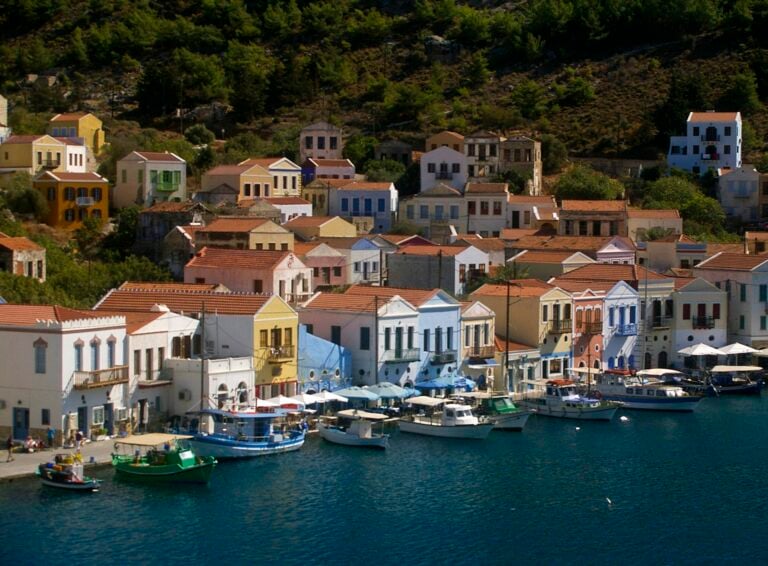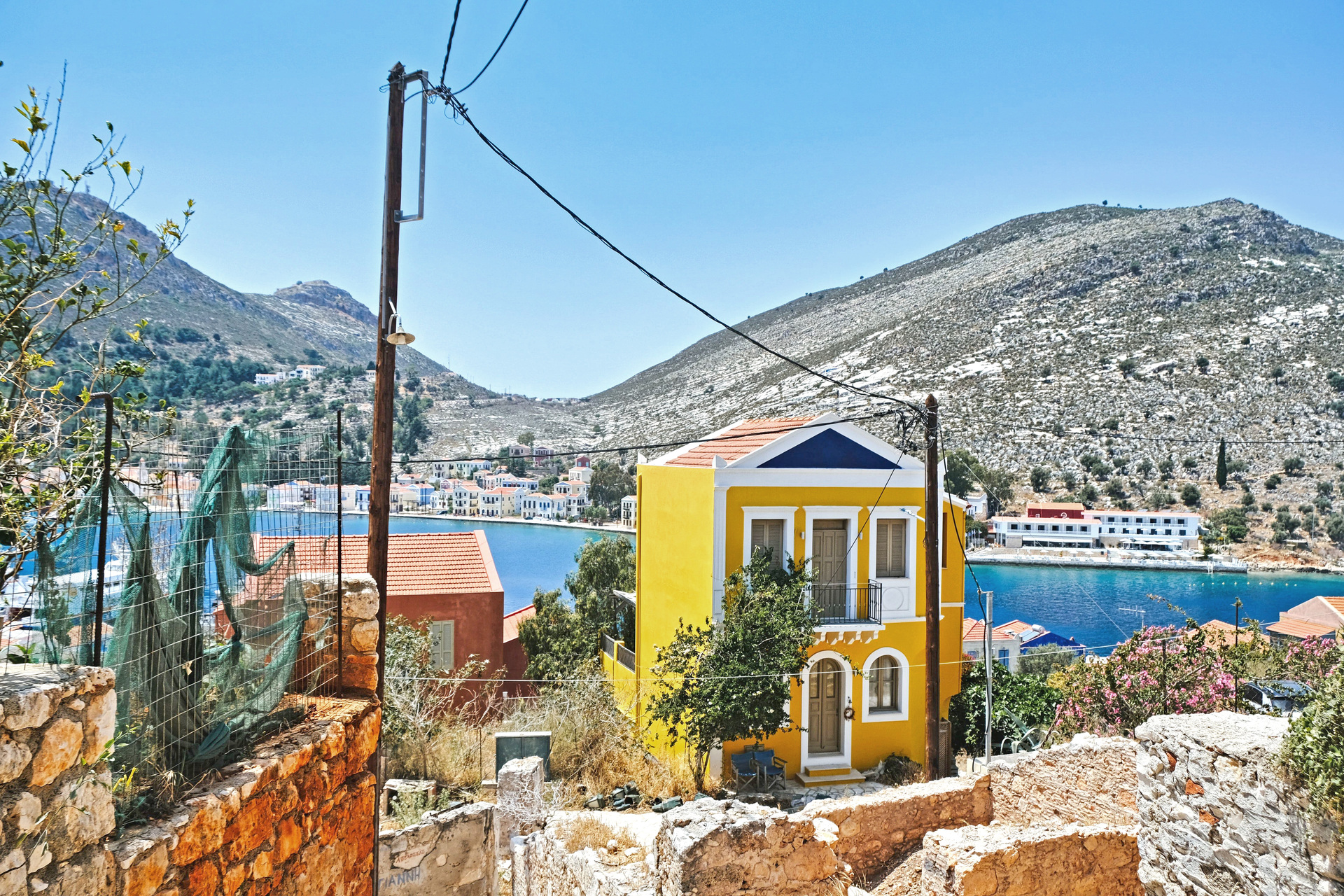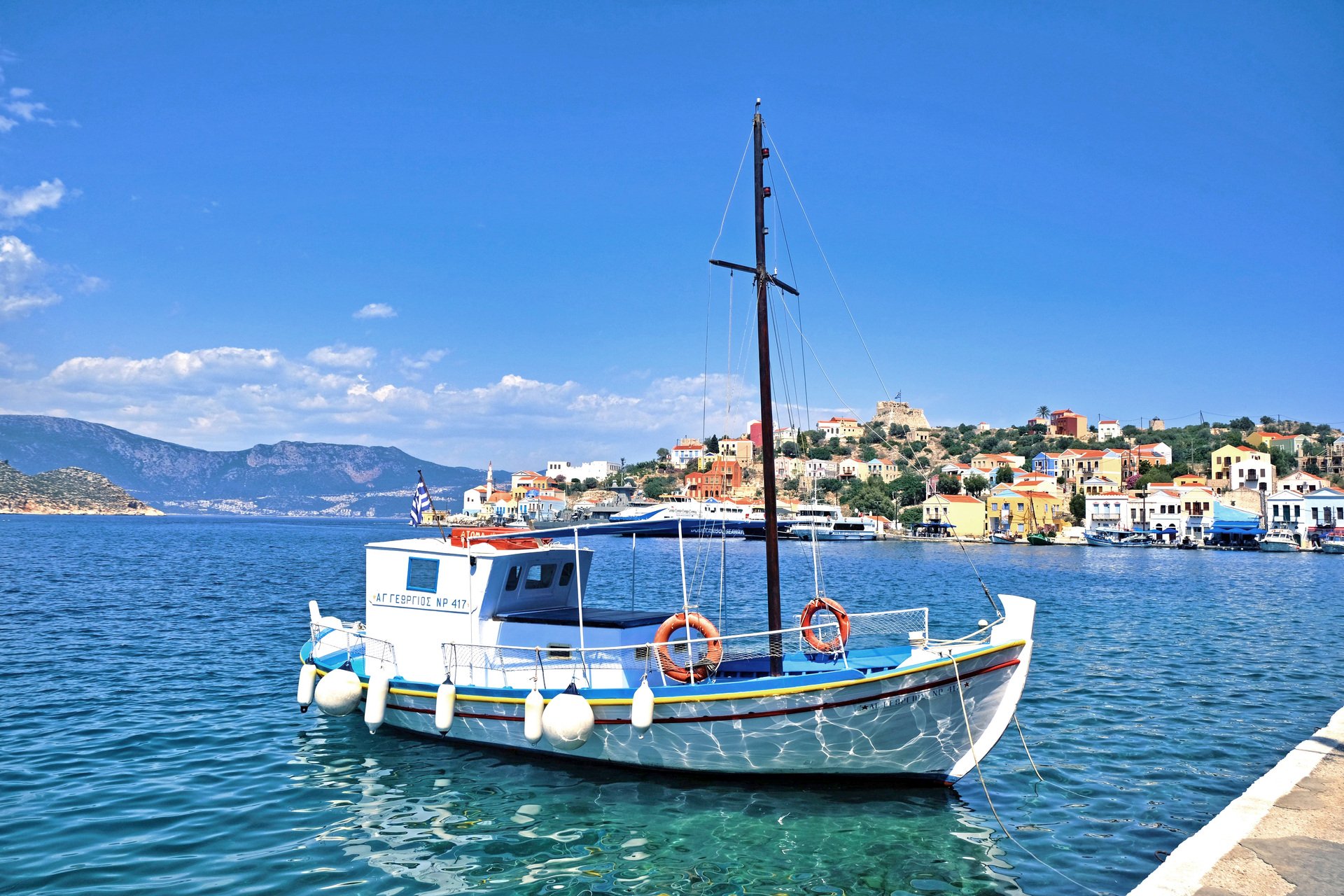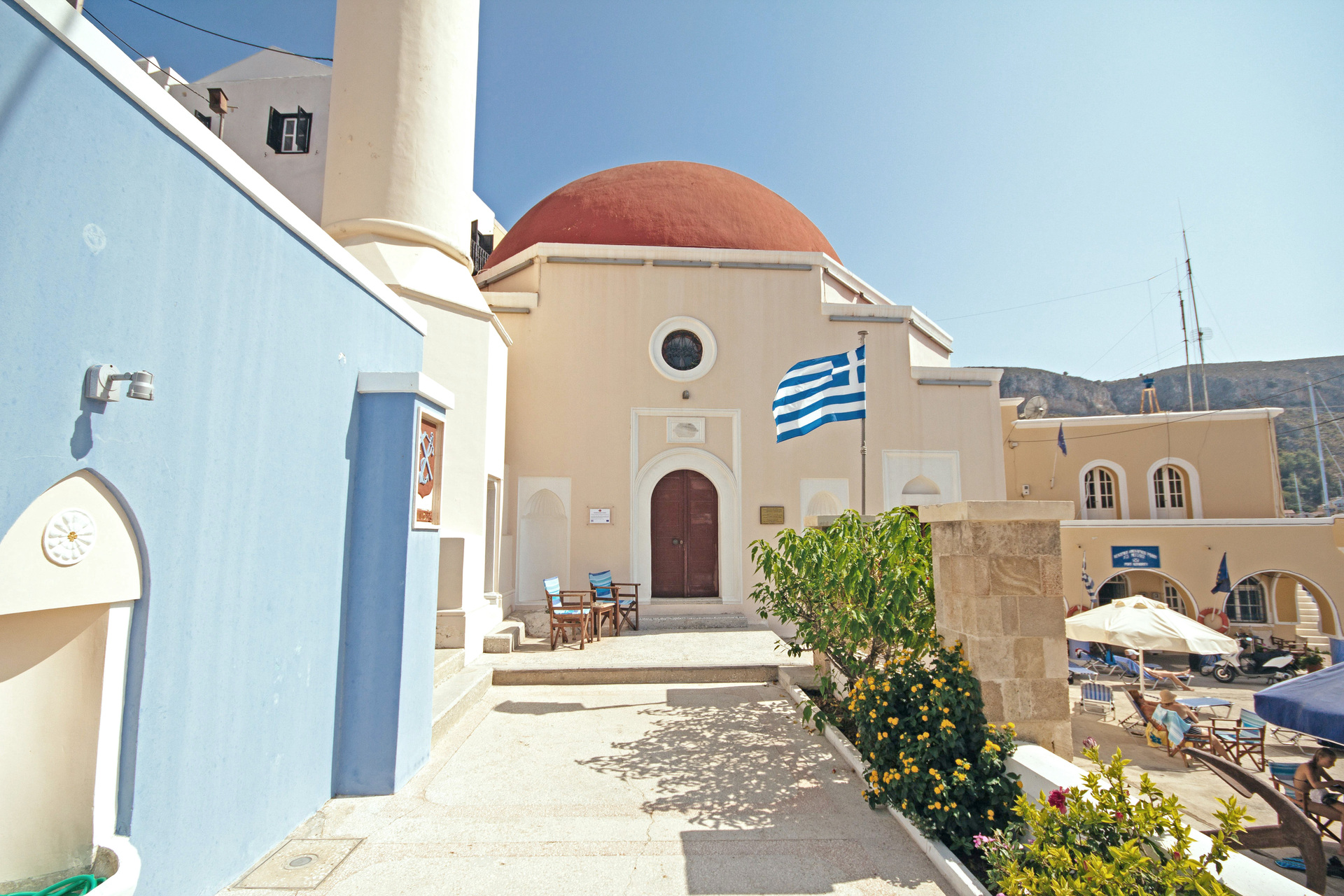This Greek island is remote. It’s as if Zeus hurled Kastellorizo from faraway Mt Olympus to the edge of the Dodecanese, just 2km from the Turkish coast. And this rocky outpost is tiny; it’s less than 10sq km, or half the size of Rottnest. Ironically, its official name – Megisti – means big, because it’s surrounded by tiny islands. Two aspects of Kastellorizo stand out: Kastellorizo’s remarkable history and survival, and the super-glue bond of its Australian descendants, “Kassies”. More on this later.
Finally, the ferry from Rhodes rounds a headland into Kastellorizo’s deep, U-shaped harbour bathed in golden sunlight that’s sliced with an inky-black shadow from a massive escarpment. The Greek flag flies over a stone castle ruins dominating the skyline.

A red-topped minaret stands sentinel at the entrance. Terraces of mansion houses radiate their vibrant colours. Ocean-going yachts bob, and people scatter from their café tables lining the narrow Kordoni (walkway) around the harbour with a shattering a foghorn blast. It’s theatrical. And after a week’s absence, the isolated crowd’s eager to greet our ferry.

While there’s much to see here, it’s easy to experience most sights in a day or two. I’m here for seven days, necessitating significant changing of gears, adjusting to the slow daily routine. It’s late in the tourist season with fewer yachts moored and only one cruise ship from Cyprus for a four-hour stop.
Now accommodated, I start my circumnavigation of this harbour-side village from my spot at Radio Café on the waterfront. Two-storey houses rise steeply behind the Kordoni, many restored in vibrant colours, some crumbling, all the former mansions of a wealthy shipping class. At the harbour entrance the mosque, a legacy of the Ottoman occupation, is now a cultural centre presenting its treasure of a black and white film featuring many former residents giving their first-account history of the island.

Steep steps winding around close-knit houses reveal the Church of St Nicholas with its stone bell tower and frescoes. Around the corner a small, courtyard-based museum displays a collection from the island and wider Dodecanese. Higher up is the scuttled shell of the Knights Castle. Prominently placed, it’s a stand-out feature over the harbour with views across the Aegean to the Turkish town of Kaș. It stands out at night too – under floodlights.
I step through centuries in a few metres finding remnants of a Turkish hamman and a granary before taking the high stone path clinging to the shoreline to picturesque Mandraki. It means “little harbour” and traditionally provides shipbuilding and maintenance services. Stillness hovers over bougainvillea-covered houses, far from boisterous cafés. Diverting to visit the 6th century Lycian tomb cut into the rock, I find the recommended, and welcome, spot for a cooling swim.

There are no beaches in Kastellorizo; it’s not that sort of island. Swimming starts with walking down rocks or stone steps, and includes footwear. If the silky water is not wondrous enough, underwater is spectacular. The rock ledge drops near-vertically to unfathomable depths. Crystal-clear turquoise and blue dissolve into a kaleidoscope with pinpricks of sunlight shafting through skittish, silvery fish. Everywhere there’re broken amphorae. It’s wonderous.
I circle back via the tiny village of Horáfia and the Church of St Constantine and St Helen. Built in 1835 it’s a three-aisled domed basilica with an intricate pebble floor and filled with icons. Outside, the square features a life-size statue of “the lady of Ro”, a local patriot who heroically defied the Turks by daily hoisting the Greek flag on the island speck, Ro. It’s siesta time. For future exploring there remains the Blue Grotto, Kaș and the high hinterland.
Arguably Kastellorizo’s premier attraction, the Blue Grotto (Parasta) on the south east, is a 45-minute boat-ride away. The low, slit entrance to this sea cave allows cautious access only at low tide. Once inside the large chamber, with its stalactites and the odd seal, the magic of light begins. Its angle infuses the space with a strange blue light. Another must-do exploration is a boat ride to Ka, founded by Kastellorizians. It’s a lovely tourist town of 8,000 – Turkey’s gem on the Turquoise Coast. Friends and I hire a fisherman for transport. We shop and walk to the ancient amphitheatre, later enjoying a splendid open-air dinner before returning, in pitch-dark, to “our” island.

A stone path slashes a white zig-zag across the black, near-vertical escarpment at the foot of the harbour. It’s quite a climb, best done early in the day. With each step there’s an ever-higher, panoramic view between Cyprus pines of both harbour and village. The last step presents a different landscape: a flat, rocky and barren plateau with barely a weed. A goat stares. It’s hot and the silence is palpable. There’s evidence of habitation, with the ruins of St George of the Mountain monastery.
An extremely brief history of Kastellorizo could be characterised as: “caught in the crossfire”. The Knights of St John, who ruled the eastern Mediterranean from 1309-1522, built their castle here on the crossroads of ancient sea lanes. They were ousted by the Venetians who were ousted by the Ottomans. But it’s recent history that Kassies remember. In 1913 the islanders rebelled against a diminishing Ottoman Empire but were abandoned by Athens. Kastellorizo became a pawn of the Great Powers in two world wars. The entire population of 15,000 was evacuated during WWII before the village was flattened by German bombing then razed by fire; a once prosperous community reduced to rubble. Most chose not to return. Many settled in Australia. Today there are 327 Kassies on the island plus 50,000+ Kassie descendants in Australia.

It’s those Kassies from the diaspora that I see, and hear, around me. My visit coincides with the AFL Grand Final. It’s odd to see scores of Aussies yelling at TV screens in these tiny harbour-side cafes. Locals look bemused or, heads down, ply the barrackers with food, ouzo and coffee. My host, Byron Kakulas, grandson of an immigrant from the 1913 exodus, is typical of his generation of Kassies. He and wife Val invested both time and fortune lovingly restoring his family home (title lost in the war) battling bureaucracies and scarce building trades. It’s a joy moving between Kassie families, many inter-related, some with three generations here. We gather for dinners and outdoor dancing. I hear of “Kassie fever”, an irrational exuberance, particularly buying degraded property, and the phrase “giving back to the island of our forebears”.
Old men tell me youthful tales of building houses in Darwin or picking grapes at Mildura. Unable to adjust they returned from remote Australia to remote Kastellorizo. Some Kassies visit occasionally, others once or twice a year but all enjoy a strong bond of Greek, and particularly Kastellorizian heritage. It’s a casual, carefree atmosphere of kinship and a privilege I share briefly. Now I have to leave this little treasure island with a big heart – it’s treasure.